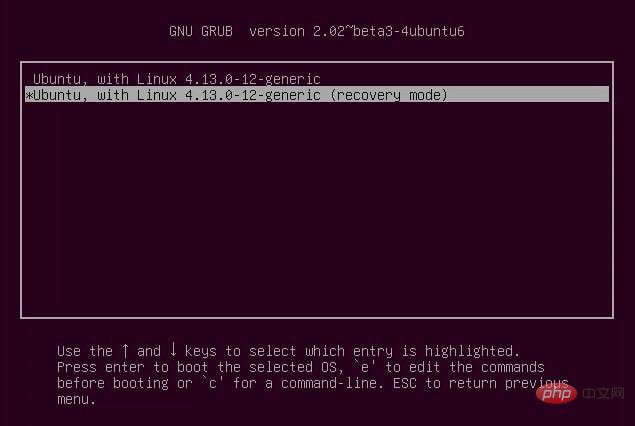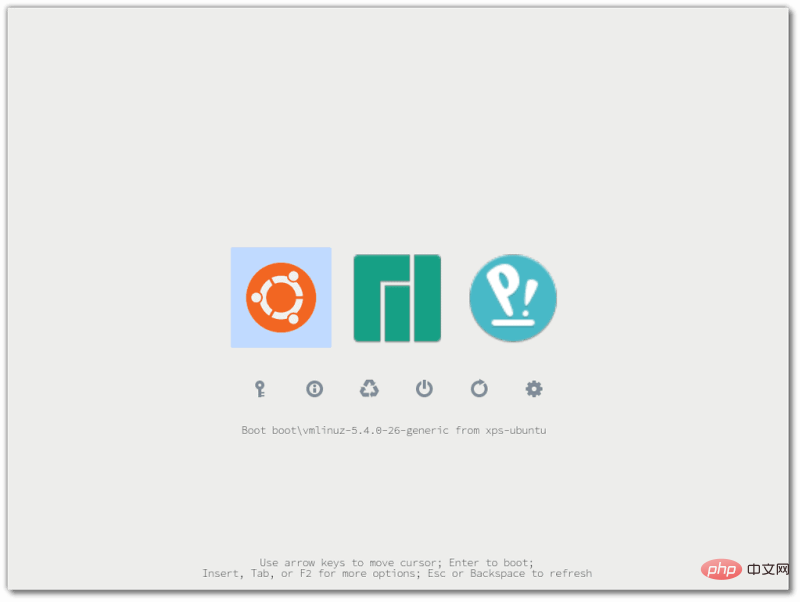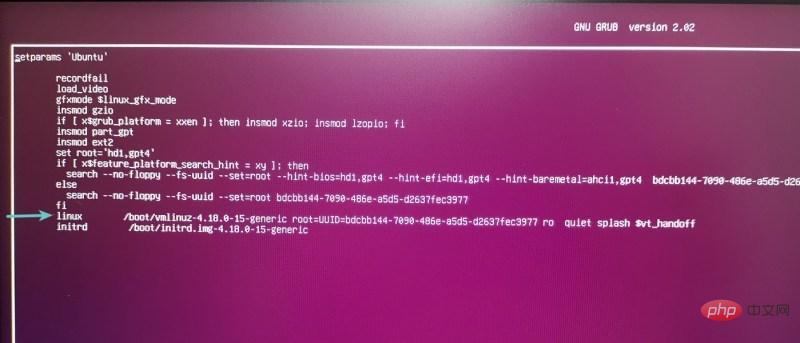what is linux grub
In Linux, grub is a complete program used to load and manage system startup. It is a boot program; it is the first software that runs when the computer starts, and loads the kernel of the operating system. It is up to the kernel to initialize other parts of the operating system. grub supports LBA, which puts the addressing translation used to find files into the hard drive's firmware.

The operating environment of this tutorial: Ubuntu 16.04 system, Dell G3 computer.
GRUB in Linux
GRUB is a complete program for loading and managing system startup. It is the most common bootloader in Linux distributions. The bootloader is very important because without it the operating system cannot be started.
The boot program is the first software that runs when the computer starts. The boot loader transfers control to the operating system kernel.
It loads the kernel of the operating system, and then the kernel initializes other parts of the operating system (including Shell, display manager, desktop environment, etc.).
GRUB is the default bootloader for many Linux distributions. This is because it is better than many previous versions of bootloaders. Some of its features are:
GRUB supports LBA (Logical Block Addressing Mode), which puts the addressing translation used to find files into the hard drive’s firmware
GRUB provides maximum flexibility to load the required options for the operating system using a command-based pre-operating system environment.
Boot options such as kernel parameters can be modified using the GRUB command line.
There is no need to specify the physical location of the Linux kernel for GRUB. It only requires the kernel's hard drive number, partition number and file name.
GRUB can start almost all operating systems using direct loading and chain loading startup methods.
Boot Program and Boot Manager
I don’t want to confuse you right now, but I think this topic It is inevitable. There is a blurry line between the boot loader and the boot manager.
You already know what a bootloader is. It starts first, then loads the kernel into memory and executes it. The boot manager allows you to choose between different operating systems (if you have more than one operating system on your computer). The boot manager does not load the system directly.
With the introduction of Linux kernel version 3.3, the Linux kernel includes a built-in EFI bootloader. In fact, any EFI-enabled system includes an EFI bootloader. In systems that support EFI, the firmware reads the EFI files in the EFI System Partition (ESP) to obtain boot information.
Insert a picture here, which shows the partition table with the ESP partition:

GRUB is both a boot program and a boot manager . I'll talk about GRUB in a moment. Let's first look at other GRUB-like programs.
Little knowledge: GRUB is the abbreviation of GRand Unified Bootloader.
GRUB What do those lines on the screen mean?
You will see a few lines on the GRUB screen. These lines will be different for different setups and different distributions.
Normally, the first line is your Linux distribution. If you see something like advanced options, you can go into it and find some lines that start with "linux-generic-x-y-z" etc.
When your Linux distribution updates a kernel version, it will keep at least one older version. You can choose to boot into an older Linux kernel in case your system encounters any issues with the newly updated Linux kernel.
In Ubuntu-based distributions, you may also see a recovery option.

At the end, you may see an entry such as System Settings or UEFI Settings to access your system's BIOS settings.
What other boot managers are similar to GRUB?
GRUB is the most popular boot manager in Linux. But it's not the only one. There is a highly customizable boot manager called rEFInd Boot Manager, which is also loved by some Linux users.

There is also a text-based boot manager called systemd-boot. As you can guess this is intended for systemd based Linux distributions. There are some distributions that are using systemd-boot, such as Pop OS.

Accessing or editing GRUB
Normally the GRUB screen you see is its menu interface. If you have more than one operating system installed, it will allow you to choose one to start. If your Linux distribution has more than one kernel installed, you can also choose to load a different kernel.
Depending on the configuration of different Linux distributions, there may be some other options on your GRUB menu.
You can press the e key in the GRUB menu interface to edit menu items. This way you can modify the parameters of the kernel before it is loaded. For example, in some cases, disabling the graphics driver provided by the kernel can help you solve the problem of Linux system getting stuck at startup.

You can also press the c key on the GRUB menu interface to enter the GRUB command line menu.
GRUB Configuration File
Any changes you make to GRUB in the menu interface are temporary. If you want to make some permanent changes to GRUB, such as changing the default timeout, you can modify the GRUB configuration file after the Linux system starts.
The default GRUB configuration file is /etc/default/grub. There is also a /etc/default/grub.d directory, which also stores some configurations. You can edit the /etc/default/grub file directly, but I recommend making additional modifications by adding configuration files (.cfg files) in this directory.
You must update GRUB for these changes to take effect.
Use the GRUB Customizer to customize GRUB
If you are not used to using a text editor to edit files in the terminal, you can use a A graphical tool called GRUB Customizer.
It allows you to change the startup sequence, default timeout, etc. You can also use it to set the GRUB background to a custom wallpaper.
The GRUB customizer can be installed from the Universe repository in Ubuntu 20.04 and via a PPA in Ubuntu 18.04. It is available in Arch Linux-based distributions via the AUR.
Related recommendations: "Linux Video Tutorial"
The above is the detailed content of what is linux grub. For more information, please follow other related articles on the PHP Chinese website!

Hot AI Tools

Undresser.AI Undress
AI-powered app for creating realistic nude photos

AI Clothes Remover
Online AI tool for removing clothes from photos.

Undress AI Tool
Undress images for free

Clothoff.io
AI clothes remover

Video Face Swap
Swap faces in any video effortlessly with our completely free AI face swap tool!

Hot Article

Hot Tools

Notepad++7.3.1
Easy-to-use and free code editor

SublimeText3 Chinese version
Chinese version, very easy to use

Zend Studio 13.0.1
Powerful PHP integrated development environment

Dreamweaver CS6
Visual web development tools

SublimeText3 Mac version
God-level code editing software (SublimeText3)

Hot Topics
 What computer configuration is required for vscode
Apr 15, 2025 pm 09:48 PM
What computer configuration is required for vscode
Apr 15, 2025 pm 09:48 PM
VS Code system requirements: Operating system: Windows 10 and above, macOS 10.12 and above, Linux distribution processor: minimum 1.6 GHz, recommended 2.0 GHz and above memory: minimum 512 MB, recommended 4 GB and above storage space: minimum 250 MB, recommended 1 GB and above other requirements: stable network connection, Xorg/Wayland (Linux)
 Linux Architecture: Unveiling the 5 Basic Components
Apr 20, 2025 am 12:04 AM
Linux Architecture: Unveiling the 5 Basic Components
Apr 20, 2025 am 12:04 AM
The five basic components of the Linux system are: 1. Kernel, 2. System library, 3. System utilities, 4. Graphical user interface, 5. Applications. The kernel manages hardware resources, the system library provides precompiled functions, system utilities are used for system management, the GUI provides visual interaction, and applications use these components to implement functions.
 vscode terminal usage tutorial
Apr 15, 2025 pm 10:09 PM
vscode terminal usage tutorial
Apr 15, 2025 pm 10:09 PM
vscode built-in terminal is a development tool that allows running commands and scripts within the editor to simplify the development process. How to use vscode terminal: Open the terminal with the shortcut key (Ctrl/Cmd). Enter a command or run the script. Use hotkeys (such as Ctrl L to clear the terminal). Change the working directory (such as the cd command). Advanced features include debug mode, automatic code snippet completion, and interactive command history.
 How to run java code in notepad
Apr 16, 2025 pm 07:39 PM
How to run java code in notepad
Apr 16, 2025 pm 07:39 PM
Although Notepad cannot run Java code directly, it can be achieved by using other tools: using the command line compiler (javac) to generate a bytecode file (filename.class). Use the Java interpreter (java) to interpret bytecode, execute the code, and output the result.
 How to check the warehouse address of git
Apr 17, 2025 pm 01:54 PM
How to check the warehouse address of git
Apr 17, 2025 pm 01:54 PM
To view the Git repository address, perform the following steps: 1. Open the command line and navigate to the repository directory; 2. Run the "git remote -v" command; 3. View the repository name in the output and its corresponding address.
 Where to write code in vscode
Apr 15, 2025 pm 09:54 PM
Where to write code in vscode
Apr 15, 2025 pm 09:54 PM
Writing code in Visual Studio Code (VSCode) is simple and easy to use. Just install VSCode, create a project, select a language, create a file, write code, save and run it. The advantages of VSCode include cross-platform, free and open source, powerful features, rich extensions, and lightweight and fast.
 What is the main purpose of Linux?
Apr 16, 2025 am 12:19 AM
What is the main purpose of Linux?
Apr 16, 2025 am 12:19 AM
The main uses of Linux include: 1. Server operating system, 2. Embedded system, 3. Desktop operating system, 4. Development and testing environment. Linux excels in these areas, providing stability, security and efficient development tools.
 vscode terminal command cannot be used
Apr 15, 2025 pm 10:03 PM
vscode terminal command cannot be used
Apr 15, 2025 pm 10:03 PM
Causes and solutions for the VS Code terminal commands not available: The necessary tools are not installed (Windows: WSL; macOS: Xcode command line tools) Path configuration is wrong (add executable files to PATH environment variables) Permission issues (run VS Code as administrator) Firewall or proxy restrictions (check settings, unrestrictions) Terminal settings are incorrect (enable use of external terminals) VS Code installation is corrupt (reinstall or update) Terminal configuration is incompatible (try different terminal types or commands) Specific environment variables are missing (set necessary environment variables)








